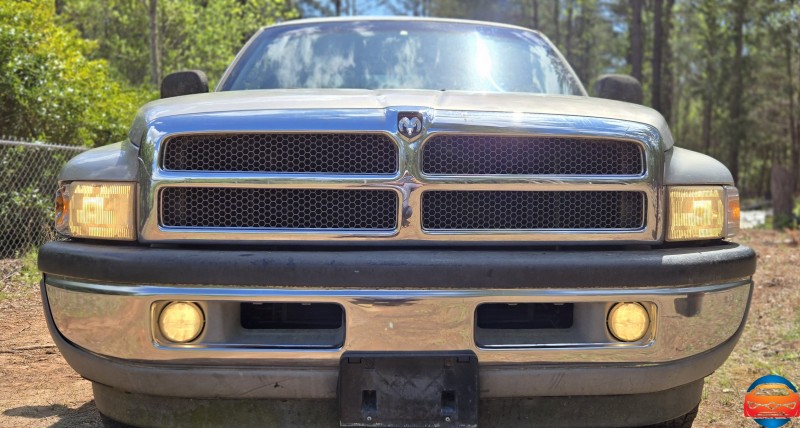-
190 Articoli
-
115 Foto
-
5 Video
-
Male
-
Seguito da 25 people
© 2025 Social AmericA Network Online
 Italiano
Italiano
Aggiornamenti recenti
-
Clearing a paint gun after finishClearing a paint gun after finish
 0 Commenti 0 condivisioni 81 Views 0 AnteprimaEffettua l'accesso per mettere mi piace, condividere e commentare!
0 Commenti 0 condivisioni 81 Views 0 AnteprimaEffettua l'accesso per mettere mi piace, condividere e commentare! -
https://autodeal.biz/index.php?qa=185&qa_1=1999-dodge-ram-1500-long-bed-pickup
 AUTODEAL.BIZ1999 dodge ram 1500 long bed pickup1999 dodge ram 5.2L rear drive, great condition under, out, inside. Runs drives perf...0 Commenti 0 condivisioni 87 Views 0 Anteprima
AUTODEAL.BIZ1999 dodge ram 1500 long bed pickup1999 dodge ram 5.2L rear drive, great condition under, out, inside. Runs drives perf...0 Commenti 0 condivisioni 87 Views 0 Anteprima -
0 Commenti 0 condivisioni 131 Views 0 Anteprima
-
How to Detect a Power Leak & Prevent Battery Drain
1️⃣ Prepare Your Car: Turn off the engine, remove the key , lock the doors , and unplug any unnecessary devices.
2️⃣ Set Up the Multimeter: Switch it to DC current mode and select the highest amp range to avoid damaging the device.
3️⃣ Disconnect the Negative Battery Cable: Use a wrench to remove the negative cable (usually black ). Make sure it doesn’t touch any metal parts.
4️⃣ Connect the Multimeter: Attach the black (negative) probe to the battery’s negative terminal, and the red (positive) probe to the disconnected cable.
5️⃣ Read the Multimeter: If there's current flow, there's a power leak! A normal reading should be under 50 milliamps. Higher readings mean a battery drain issue.
6️⃣ Find the Faulty Circuit: Check the fuses one by one . When the reading drops, you’ve found the problematic circuit.
7️⃣ Fix the Problem: Look for damaged wires , loose connections, or faulty parts. Repair or replace as needed.
Solving power leaks protects your battery and keeps your car’s electrical system running smoothly!
#Automotive #CarRepair #BatteryDrain #MechanicLife #CarTech #AutoFix #CarMaintenance #FYP #Viral
By #technopedia
https://www.facebook.com/share/1ARALBuaLM/🔋🚗 How to Detect a Power Leak & Prevent Battery Drain ⚡🔍 1️⃣ Prepare Your Car: Turn off the engine, remove the key 🔑, lock the doors 🚪, and unplug any unnecessary devices. 2️⃣ Set Up the Multimeter: Switch it to DC current mode ⚡ and select the highest amp range to avoid damaging the device. 3️⃣ Disconnect the Negative Battery Cable: Use a wrench 🔧 to remove the negative cable (usually black ⚫). Make sure it doesn’t touch any metal parts. 4️⃣ Connect the Multimeter: Attach the black (negative) probe to the battery’s negative terminal, and the red (positive) probe to the disconnected cable. 5️⃣ Read the Multimeter: If there's current flow, there's a power leak! 🚨 A normal reading should be under 50 milliamps. Higher readings mean a battery drain issue. 6️⃣ Find the Faulty Circuit: Check the fuses one by one 🔎. When the reading drops, you’ve found the problematic circuit. 7️⃣ Fix the Problem: Look for damaged wires 🔥, loose connections, or faulty parts. Repair or replace as needed. ✅ Solving power leaks protects your battery and keeps your car’s electrical system running smoothly! ⚙️🚘 #Automotive 🔧 #CarRepair 🚗 #BatteryDrain ⚡ #MechanicLife 🔥 #CarTech 🏁 #AutoFix 🔍 #CarMaintenance 🚘 #FYP 🚀 #Viral 🚗 By #technopedia https://www.facebook.com/share/1ARALBuaLM/0 Commenti 0 condivisioni 404 Views 0 Anteprima -
KotaKota
 WWW.NATIONALSUPPLYS.COMKOTA HVLP SPRAY GUN PAINT WITH 1.3 or 1.4 MM NOZZLE (W/O CUP)KOTA HVLP SPRAY GUN PAINT WITH 1.3 or 1.4 MM NOZZLE (W/O CUP) This SPRAY GUN is Flexible application. Ergonomic. Easy handling. With the KOTA HVLP SPRAY GUN, painters can adjust the inlet pressure and the painting distance according to the paint used, the climatic conditions and their working style – and achieve perfect results in any situation. Robust and light – with ergonomic adjustment elements, the KOTA HVLP SPRAY GUN ensures comfortable working. The KOTA HVLP SPRAY GUN is designed to use a high volume of air at a low pressure to atomize and spray paint, use a large volume of air to atomize the paint particles, which creates a fine mist that can be sprayed onto the surface being painted. The low pressure allows for a more controlled spray pattern and reduces the amount of overspray. Product Benefits Flexible application: Optimized nozzle concept for various spray distances and inlet pressures Ergonomic design: Pleasant and compact handle shape combined with easy-to-operate control elements Fine adjustment: Optimized round / flat spray fan control with a half turn Suitable areas of application Car Refinish Industrial Applications Carpentry Decorative Painting Product information Nozzle Size: 1.3 or 1.4 mm Spray Gun Body Material: Aluminum HVLP: Paint spray guns achieve particularly high transfer rates with their low-pressure technology. Fits with Adapter: #2 (not Included)0 Commenti 0 condivisioni 118 Views 0 Anteprima
WWW.NATIONALSUPPLYS.COMKOTA HVLP SPRAY GUN PAINT WITH 1.3 or 1.4 MM NOZZLE (W/O CUP)KOTA HVLP SPRAY GUN PAINT WITH 1.3 or 1.4 MM NOZZLE (W/O CUP) This SPRAY GUN is Flexible application. Ergonomic. Easy handling. With the KOTA HVLP SPRAY GUN, painters can adjust the inlet pressure and the painting distance according to the paint used, the climatic conditions and their working style – and achieve perfect results in any situation. Robust and light – with ergonomic adjustment elements, the KOTA HVLP SPRAY GUN ensures comfortable working. The KOTA HVLP SPRAY GUN is designed to use a high volume of air at a low pressure to atomize and spray paint, use a large volume of air to atomize the paint particles, which creates a fine mist that can be sprayed onto the surface being painted. The low pressure allows for a more controlled spray pattern and reduces the amount of overspray. Product Benefits Flexible application: Optimized nozzle concept for various spray distances and inlet pressures Ergonomic design: Pleasant and compact handle shape combined with easy-to-operate control elements Fine adjustment: Optimized round / flat spray fan control with a half turn Suitable areas of application Car Refinish Industrial Applications Carpentry Decorative Painting Product information Nozzle Size: 1.3 or 1.4 mm Spray Gun Body Material: Aluminum HVLP: Paint spray guns achieve particularly high transfer rates with their low-pressure technology. Fits with Adapter: #2 (not Included)0 Commenti 0 condivisioni 118 Views 0 Anteprima -
Supercar blondie web unusual luxury vehicles around the globeSupercar blondie web unusual luxury vehicles around the globe
 SBXCARS.COMYour Gateway to Supercar Auctions | SBX Cars by Supercar BlondieJoin SBX Cars, the premier online auction platform for supercars and luxury vehicles. Bid on exclusive supercars, classic cars, and rare collectibles from around the globe. Discover your dream supercar today!0 Commenti 0 condivisioni 336 Views 0 Anteprima
SBXCARS.COMYour Gateway to Supercar Auctions | SBX Cars by Supercar BlondieJoin SBX Cars, the premier online auction platform for supercars and luxury vehicles. Bid on exclusive supercars, classic cars, and rare collectibles from around the globe. Discover your dream supercar today!0 Commenti 0 condivisioni 336 Views 0 Anteprima -
 WWW.GOODHOUSEKEEPING.COM7 Best Car Paint Sprayers of 2024, Reviewed by ProsGive your ride a shiny new coat of paint with these highly rated picks.0 Commenti 0 condivisioni 784 Views 0 Anteprima
WWW.GOODHOUSEKEEPING.COM7 Best Car Paint Sprayers of 2024, Reviewed by ProsGive your ride a shiny new coat of paint with these highly rated picks.0 Commenti 0 condivisioni 784 Views 0 Anteprima -
https://www.vettx.com/
 WWW.VETTX.COMPrivate Party Vehicle Acquisition | VETTXVETTX is the best solution for acquiring cars directly from private sellers. Maximize inventory, boost profits, and streamline your vehicle acquisition process.0 Commenti 0 condivisioni 434 Views 0 Anteprima
WWW.VETTX.COMPrivate Party Vehicle Acquisition | VETTXVETTX is the best solution for acquiring cars directly from private sellers. Maximize inventory, boost profits, and streamline your vehicle acquisition process.0 Commenti 0 condivisioni 434 Views 0 Anteprima -
How to Turn Off the "Check Engine" Light on Your Dashboard in 3 Simple Steps
1. Open the Hood:
Locate the car battery and use a wrench (socket or adjustable) to disconnect the negative cable. The negative terminal is usually marked with a minus (-) sign and may be covered by a protective cap.
2. Drain Residual Electricity:
Press and hold the horn for 30 seconds or turn on the headlights to discharge any remaining power in the system. Although neither will function without battery power, this step ensures that the capacitors are completely drained.
3. Wait for 15 Minutes:
Leave the battery disconnected for about 15 minutes to allow the vehicle's system to reset. Afterward, reconnect the negative cable to the terminal and secure it with the cap if applicable. Once reconnected, the error codes will be cleared, and the "Check Engine" light should turn offHow to Turn Off the "Check Engine" Light on Your Dashboard in 3 Simple Steps 🚗 1. Open the Hood: Locate the car battery and use a wrench (socket or adjustable) to disconnect the negative cable. The negative terminal is usually marked with a minus (-) sign and may be covered by a protective cap. 2. Drain Residual Electricity: Press and hold the horn for 30 seconds or turn on the headlights to discharge any remaining power in the system. Although neither will function without battery power, this step ensures that the capacitors are completely drained. 3. Wait for 15 Minutes: Leave the battery disconnected for about 15 minutes to allow the vehicle's system to reset. Afterward, reconnect the negative cable to the terminal and secure it with the cap if applicable. Once reconnected, the error codes will be cleared, and the "Check Engine" light should turn off0 Commenti 0 condivisioni 626 Views 0 Anteprima -
Car engine smoke can appear in different colors, and each type typically points to a specific issue. Here’s a description of the most common types of engine smoke and their possible causes:
𝟏. 𝐖𝐡𝐢𝐭𝐞 𝐒𝐦𝐨𝐤𝐞
- Thin White Smoke: Normal when starting the engine in cold weather, as it is usually just water vapor.
- Thick White Smoke: If this persists, it may indicate a coolant leak into the engine. This could be due to a blown head gasket, a cracked engine block, or a damaged cylinder head. The coolant mixing with engine oil or being burned in the combustion chamber causes the white smoke.
𝟐. 𝐁𝐥𝐮𝐞 𝐨𝐫 𝐆𝐫𝐚𝐲 𝐒𝐦𝐨𝐤𝐞
- Cause: Blue or gray smoke is typically a sign that oil is being burned in the engine. This can result from worn piston rings, valve seals, or other issues that allow oil to leak into the combustion chamber.
- Indications:
- If you notice blue smoke on acceleration, it might be an issue with piston rings.
- Blue smoke during deceleration often points to valve seal problems.
𝟑. 𝐁𝐥𝐚𝐜𝐤 𝐒𝐦𝐨𝐤𝐞
- Cause: Black smoke is usually a sign of incomplete combustion, meaning the engine is burning too much fuel.
- Potential Issues:
- Faulty fuel injectors or a clogged air filter may cause the engine to run rich (too much fuel).
- This smoke is more common in diesel engines but can also happen in gasoline engines.
- It can also indicate issues with the fuel pressure regulator or carburetor (in older cars).
𝟒. 𝐁𝐥𝐮𝐞-𝐁𝐥𝐚𝐜𝐤 𝐨𝐫 𝐆𝐫𝐚𝐲-𝐁𝐥𝐚𝐜𝐤 𝐒𝐦𝐨𝐤𝐞
- Cause: A mix of issues related to both oil burning and fuel problems can produce smoke in this color range. This can mean oil and fuel are both being consumed improperly.
𝐀𝐝𝐝𝐢𝐭𝐢𝐨𝐧𝐚𝐥 𝐂𝐨𝐧𝐬𝐢𝐝𝐞𝐫𝐚𝐭𝐢𝐨𝐧𝐬:
- Amount of Smoke: A light haze may not indicate a serious problem, but thick, persistent smoke should be checked immediately.
- Smell: The smell of the smoke can also provide clues. Sweet-smelling smoke usually points to coolant burning, while burnt oil has a distinctive, acrid smell.
If you're seeing any unusual smoke coming from your car’s exhaust, it’s best to have it inspected to prevent further damage.
Ashraf Makhinons HamzaCar engine smoke can appear in different colors, and each type typically points to a specific issue. Here’s a description of the most common types of engine smoke and their possible causes: 𝟏. 𝐖𝐡𝐢𝐭𝐞 𝐒𝐦𝐨𝐤𝐞 - Thin White Smoke: Normal when starting the engine in cold weather, as it is usually just water vapor. - Thick White Smoke: If this persists, it may indicate a coolant leak into the engine. This could be due to a blown head gasket, a cracked engine block, or a damaged cylinder head. The coolant mixing with engine oil or being burned in the combustion chamber causes the white smoke. 𝟐. 𝐁𝐥𝐮𝐞 𝐨𝐫 𝐆𝐫𝐚𝐲 𝐒𝐦𝐨𝐤𝐞 - Cause: Blue or gray smoke is typically a sign that oil is being burned in the engine. This can result from worn piston rings, valve seals, or other issues that allow oil to leak into the combustion chamber. - Indications: - If you notice blue smoke on acceleration, it might be an issue with piston rings. - Blue smoke during deceleration often points to valve seal problems. 𝟑. 𝐁𝐥𝐚𝐜𝐤 𝐒𝐦𝐨𝐤𝐞 - Cause: Black smoke is usually a sign of incomplete combustion, meaning the engine is burning too much fuel. - Potential Issues: - Faulty fuel injectors or a clogged air filter may cause the engine to run rich (too much fuel). - This smoke is more common in diesel engines but can also happen in gasoline engines. - It can also indicate issues with the fuel pressure regulator or carburetor (in older cars). 𝟒. 𝐁𝐥𝐮𝐞-𝐁𝐥𝐚𝐜𝐤 𝐨𝐫 𝐆𝐫𝐚𝐲-𝐁𝐥𝐚𝐜𝐤 𝐒𝐦𝐨𝐤𝐞 - Cause: A mix of issues related to both oil burning and fuel problems can produce smoke in this color range. This can mean oil and fuel are both being consumed improperly. 𝐀𝐝𝐝𝐢𝐭𝐢𝐨𝐧𝐚𝐥 𝐂𝐨𝐧𝐬𝐢𝐝𝐞𝐫𝐚𝐭𝐢𝐨𝐧𝐬: - Amount of Smoke: A light haze may not indicate a serious problem, but thick, persistent smoke should be checked immediately. - Smell: The smell of the smoke can also provide clues. Sweet-smelling smoke usually points to coolant burning, while burnt oil has a distinctive, acrid smell. If you're seeing any unusual smoke coming from your car’s exhaust, it’s best to have it inspected to prevent further damage. Ashraf Makhinons Hamza0 Commenti 0 condivisioni 737 Views 0 Anteprima
Altre storie





















